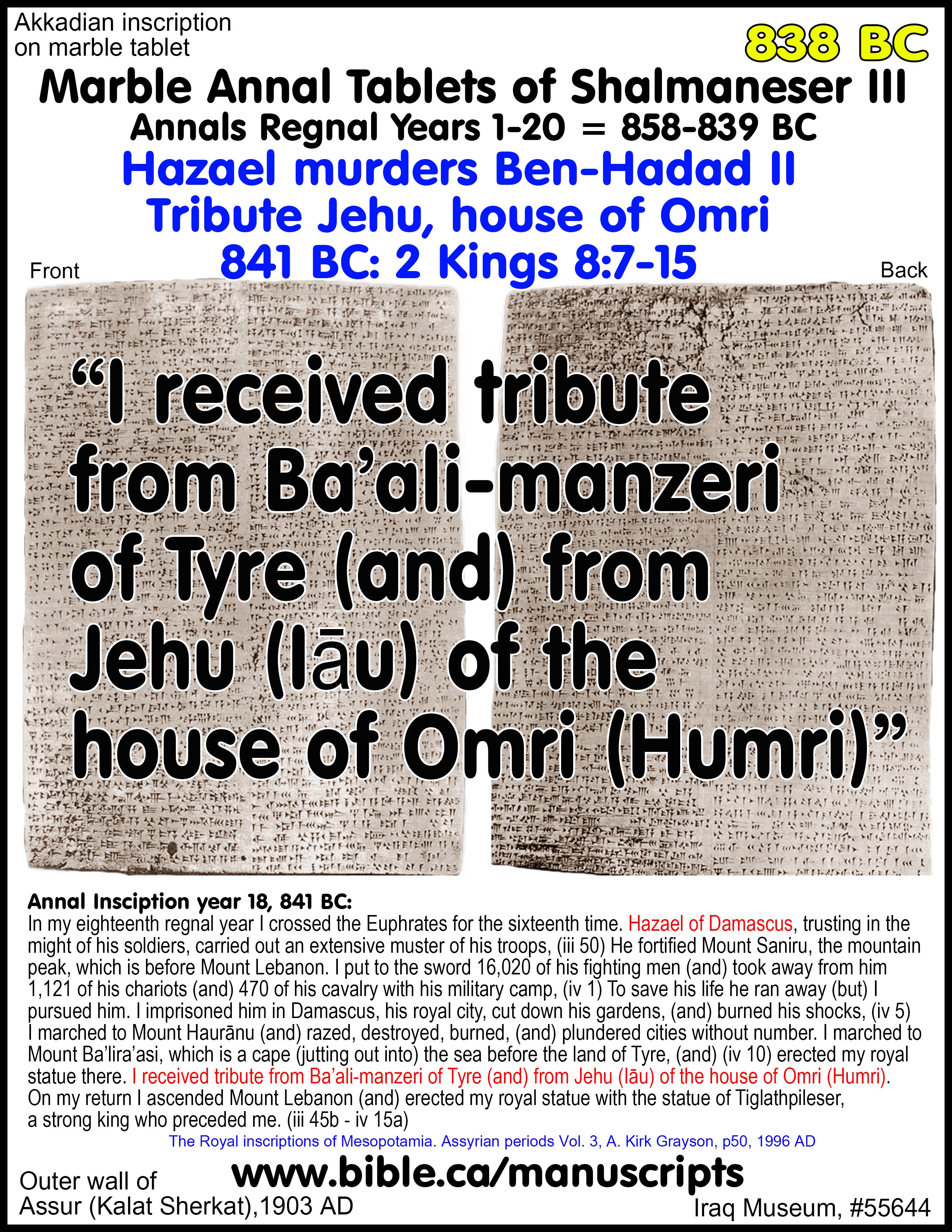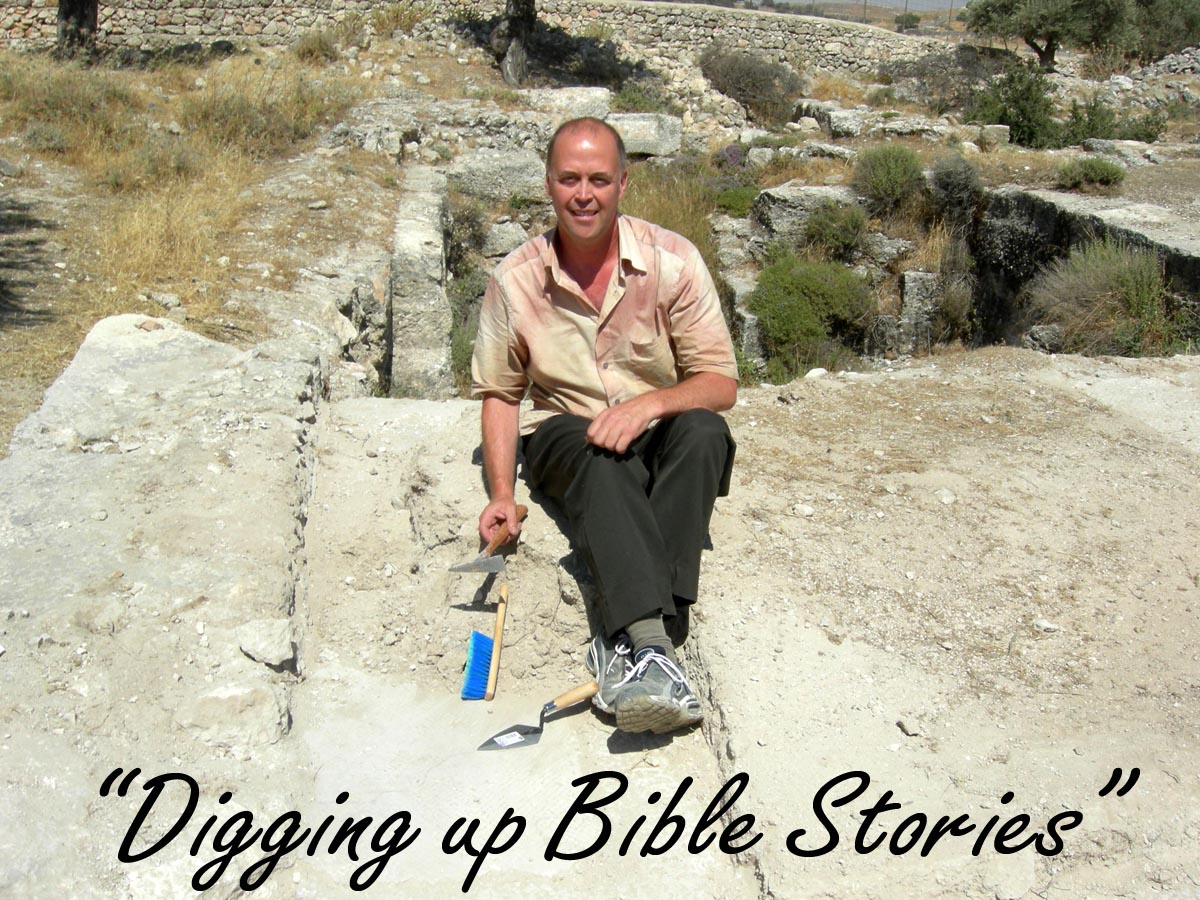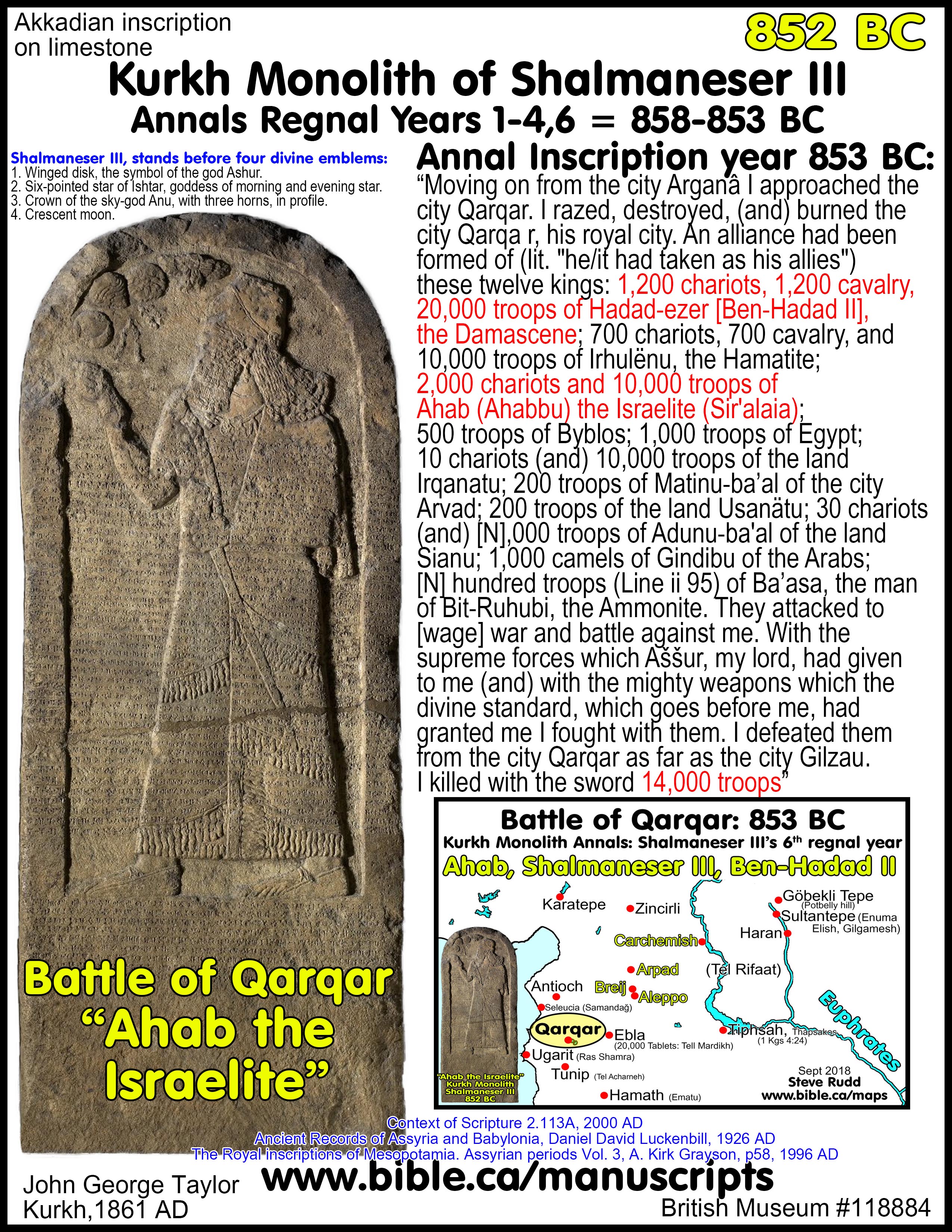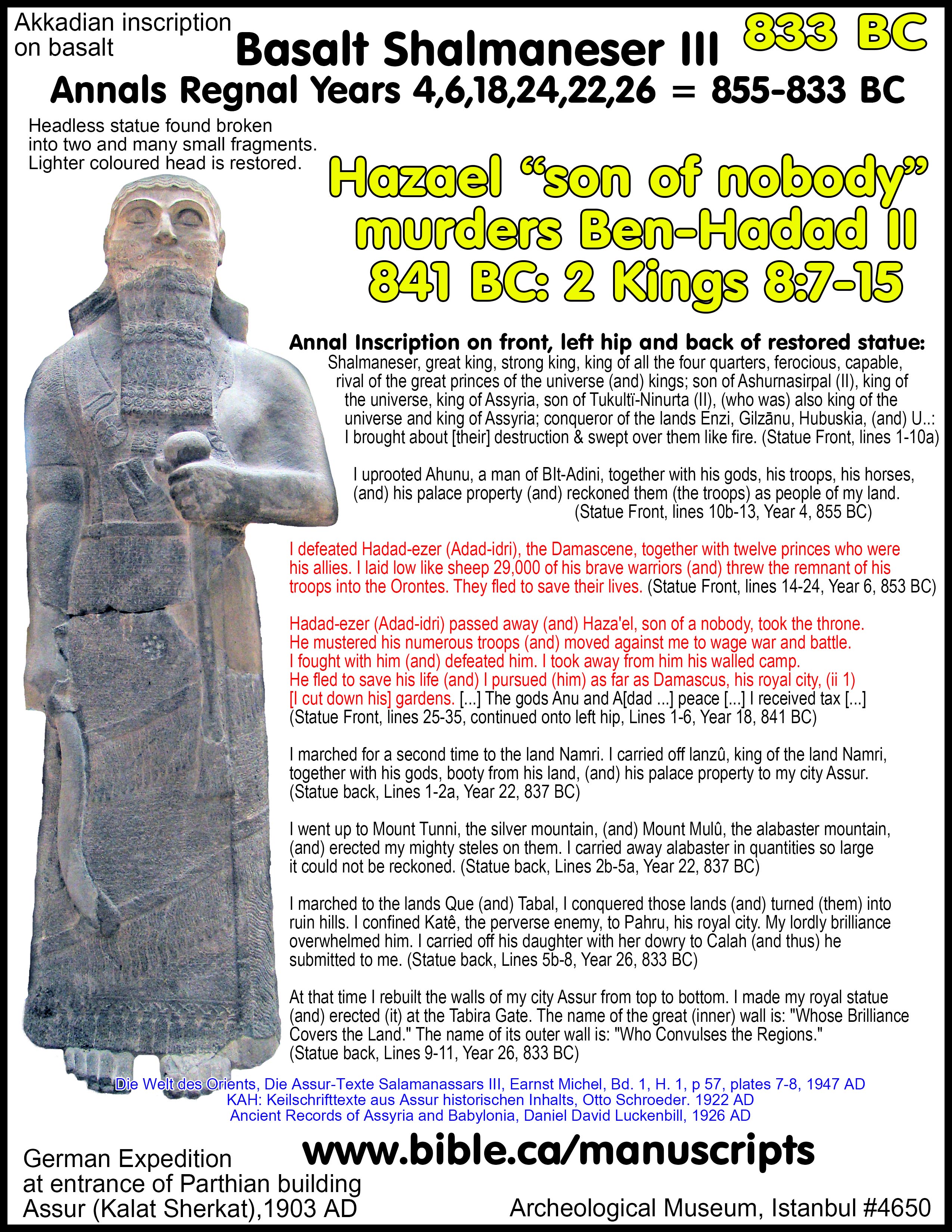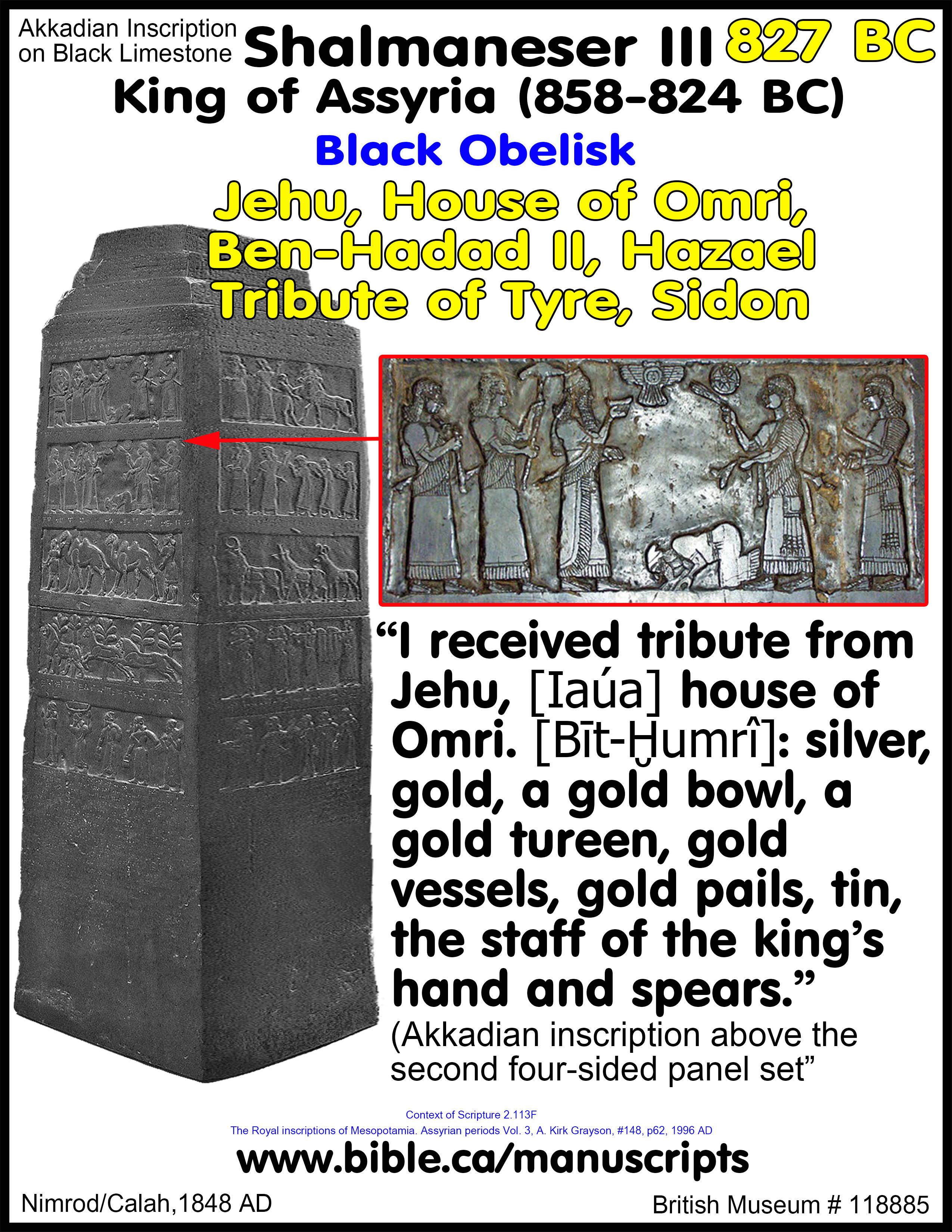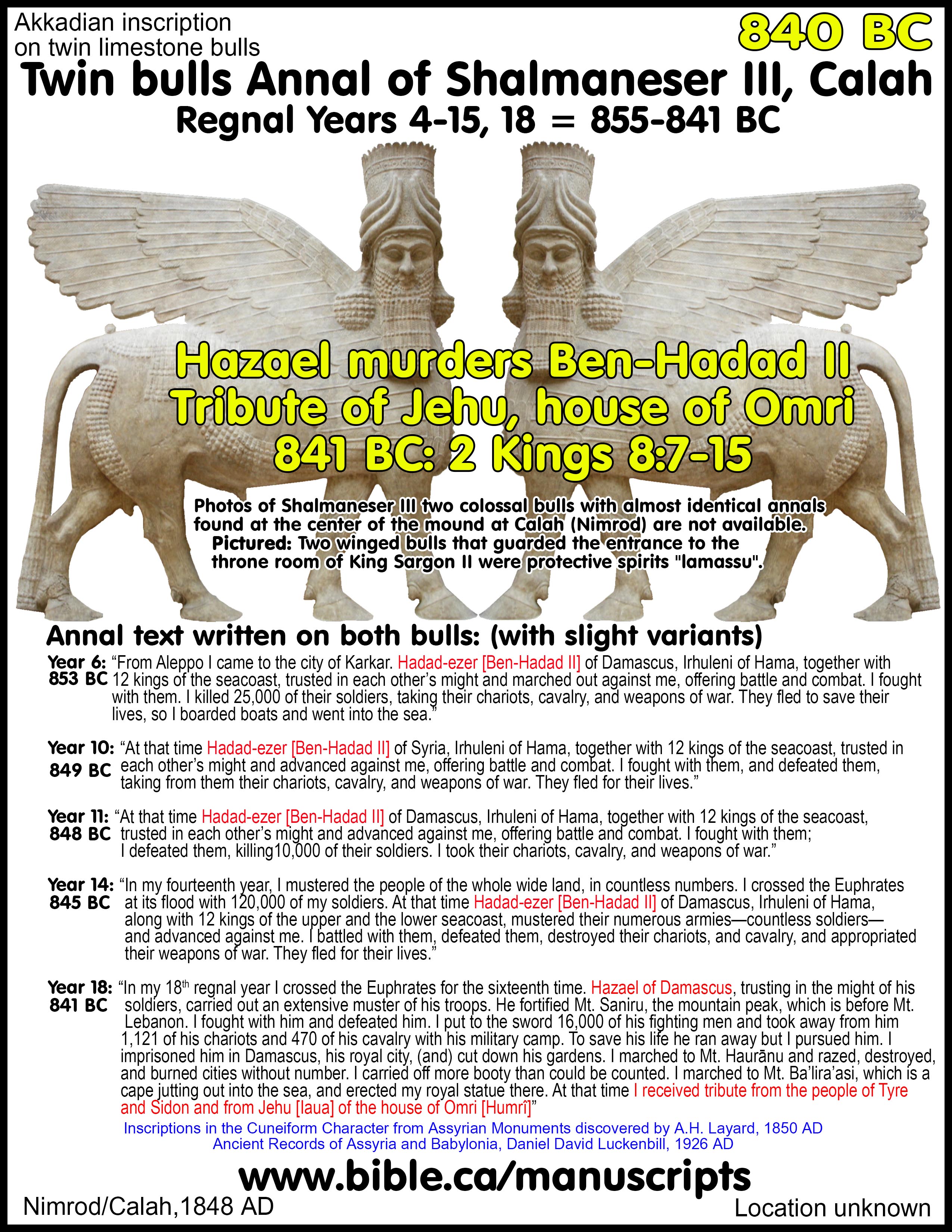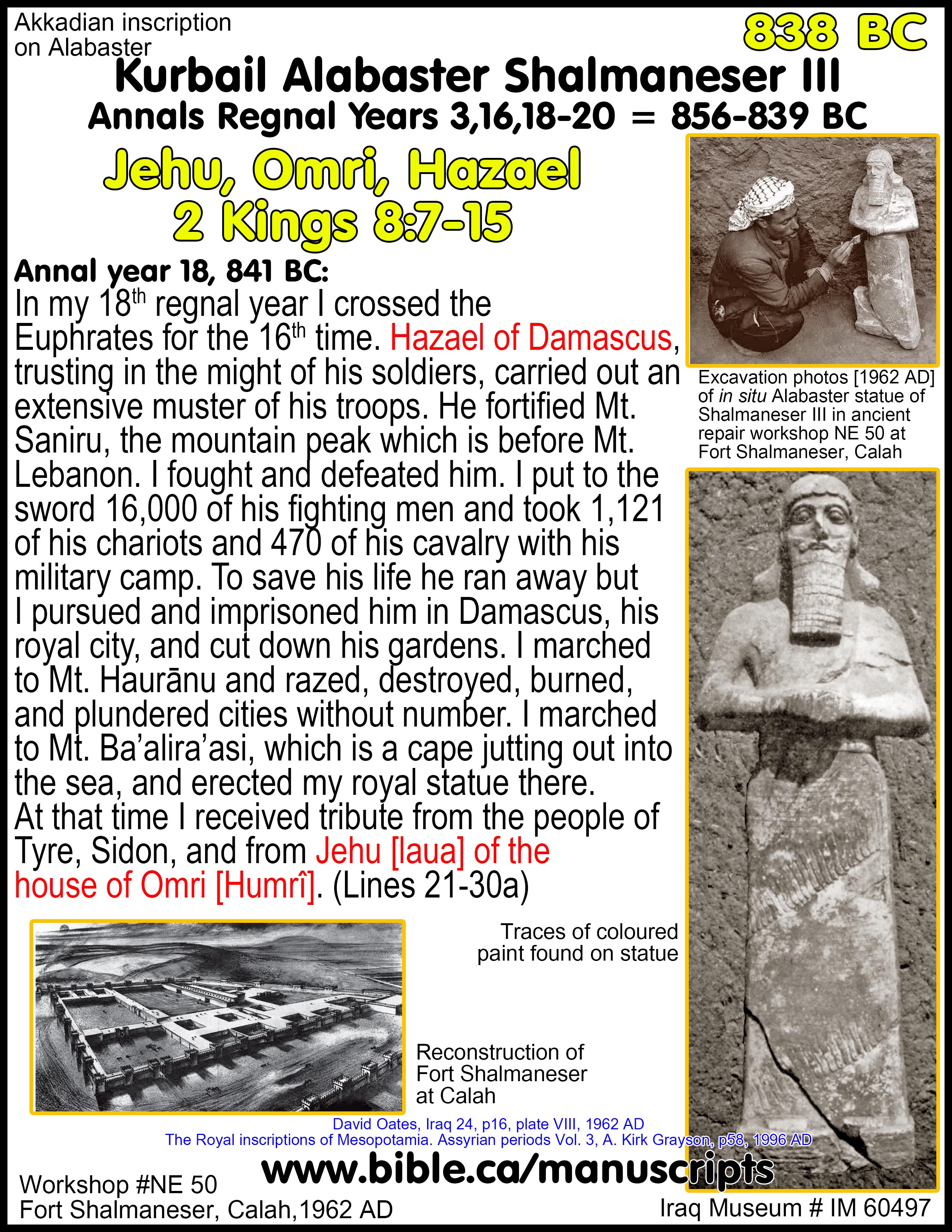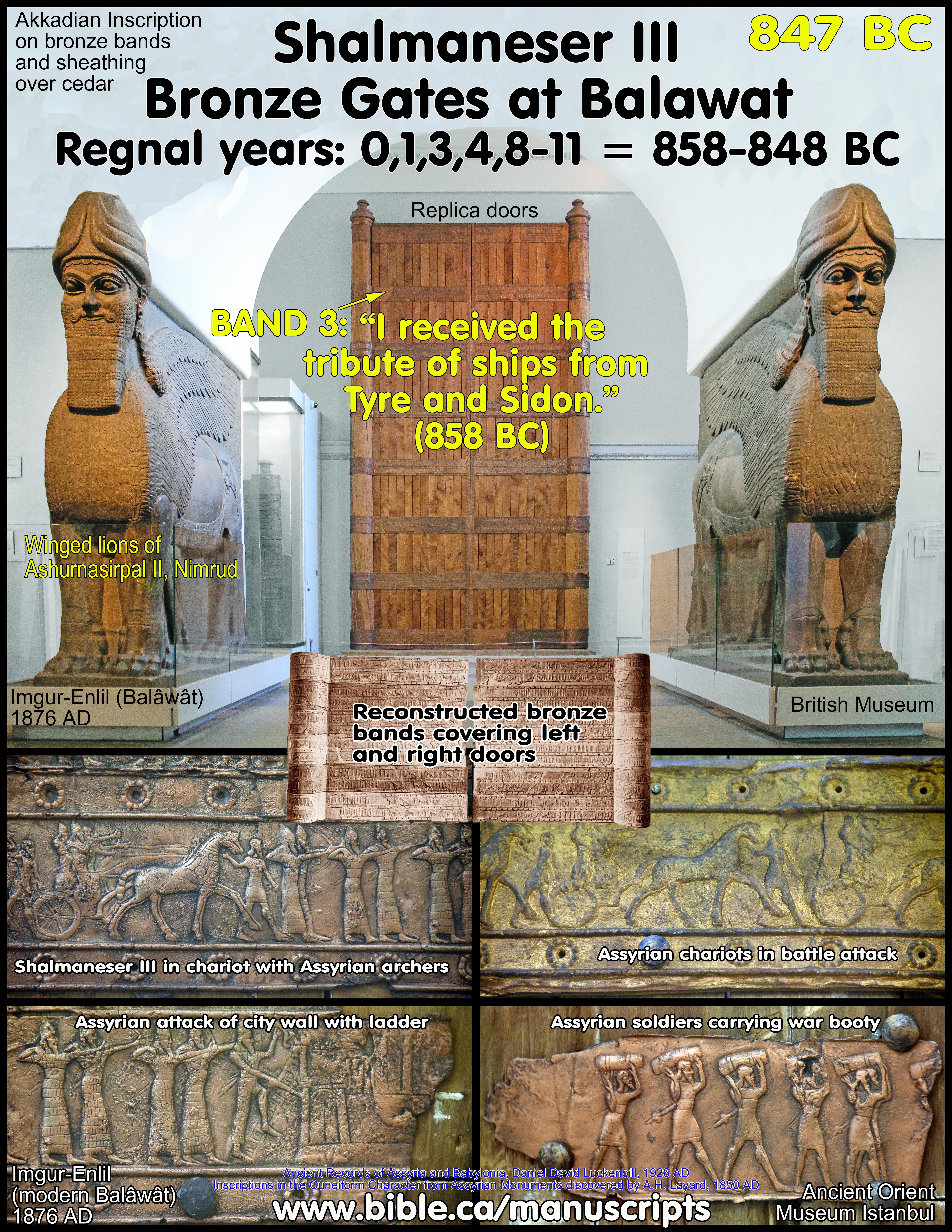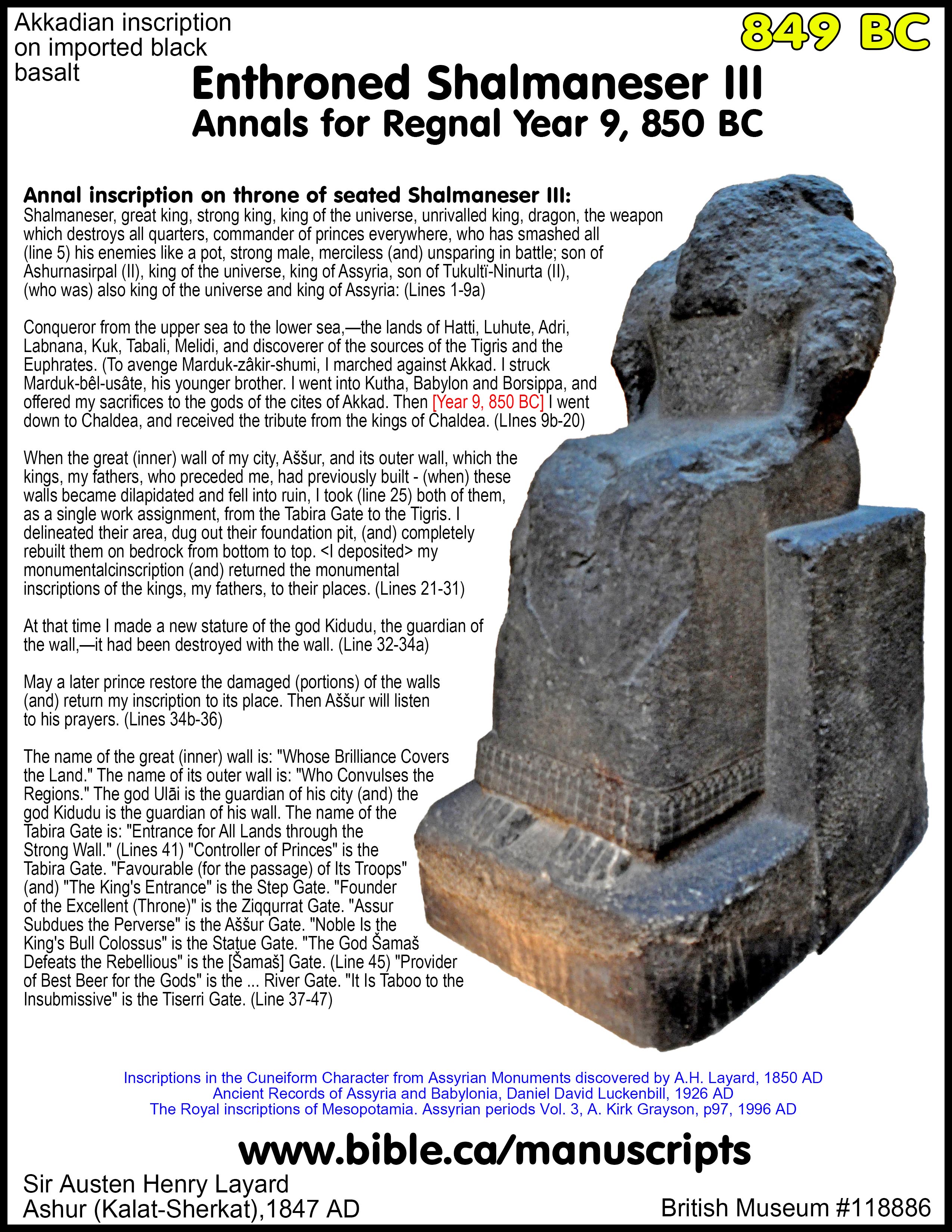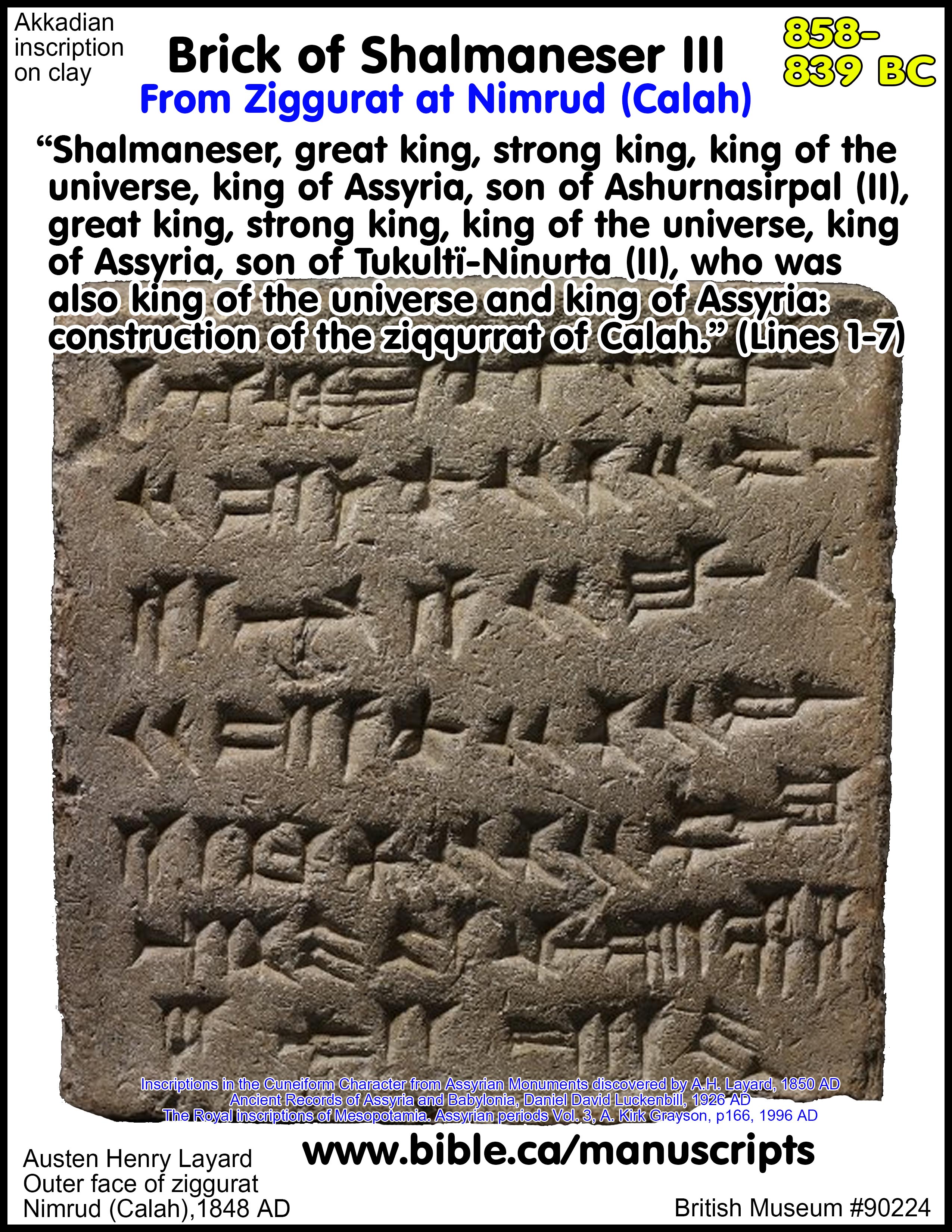Two Annal Tablets of Shalmaneser III:
1. Marble Annal Tablet of Shalmaneser III: 839 BC
2. Clay Annal Tablet of Shalmaneser III: 840 BC
Shalmaneser III, King of Assyria 855-841 BC
“Jehu, House of Omri, Ben-Hadad II, Hazael, Tyre”
See also: Detailed outline on Shalmaneser III
|
Marble Annal Tablets of Shalmaneser III |
|
|
Date of inscription |
838 BC |
|
Annal years |
858-839 BC |
|
Glyptic object |
Akkadian Inscription on marble tablet |
|
Discovery |
Outer wall of Assur (Kalat Sherkat), 1903 AD |
|
Current location |
Iraq Museum, #55644 |
|
Bible names |
Jehu, Omri, Ben-Hadad II, Hazael, Tyre |
|
Historic events |
Five of the six battles between Israel (Ahab, Jehoram and Jehu) and Assyria: It highlights the ongoing battles between Shalmaneser III of Assyria and the coalition of 12 kings under the command of Ben-Hadad II: 1. 853 BC, year 6. The battle of Qarqar 2. 849 BC, Year 10: Battle of Carchemish 3. 848 BC, Year 11: Battle of Hamath 4. 845 BC, Year 14: Battle of Hamath 5. 841 BC, Year 18: Siege of Damascus |
|
Clay Annal Tablets of Shalmaneser III Note: The text of the twin monumental bulls (Twin Bulls) and clay tablet #54669 (see Marble and clay Tablets) are almost identical. |
|
|
Date of inscription |
842 BC |
|
Annal years |
858-843 BC |
|
Glyptic object |
Akkadian Inscription on clay tablet: no photo |
|
Discovery |
Outer wall of Assur (Kalat Sherkat), 1903 AD |
|
Current location |
Iraq Museum: IM #54669) Photo at: G. G. Cameron, "The Annals of Shalmaneser III, King of Assyria: A New Text", Sumer 6, pp. 6-26 and plates I and II (IM #54669, photo, edition) 1950 AD. |
|
Bible names |
Ben-Hadad II |
|
Historic events |
Four of the six battles between Israel (Ahab, Jehoram and Jehu) and Assyria: It highlights the ongoing battles between Shalmaneser III of Assyria and the coalition of 12 kings under the command of Ben-Hadad II: 1. 853 BC, year 6. The battle of Qarqar 2. 849 BC, Year 10: Battle of Carchemish 3. 848 BC, Year 11: Battle of Hamath 4. 845 BC, Year 14: Battle of Hamath |
|
Digging up Bible stories! “In my eighteenth regnal year I crossed the Euphrates for the sixteenth time. Hazael of Damascus, trusting in the might of his soldiers, carried out an extensive muster of his troops ... I put to the sword 16,020 of his fighting men … To save his life he ran away (but) I pursued him. I imprisoned him in Damascus, his royal city, cut down his gardens, (and) burned his shocks … I received tribute from Ba’ali-manzeri of Tyre (and) from Jehu (Iāu) of the house of Omri (Humri). (Column III, line 45b – Column IV, line 15a, Marble Annal tablet)
“What we read in the book, we find in the ground” |
Introduction:
1. In 1903 AD, both the marble (IM # 55644) and clay (IM # 54669) annals tablets were found in outer wall of Assur (Kalat Sherkat), 1903 AD
a. The fact they were found together, indicate they were valued collection in ancient times.
b. Both are listed object of the Iraq Museum.
c. We have photos of the Marble tablet: IM # 55644
d. We do not have photos of the clay tablet: IM # 54669
2. Importance of the two annals tablets (marble and clay) for Bible students:
a. Most important is the famous reference to King Jehu of the house of king Omri, Ben-Hadad II, Hazael
b. The city of Tyre is listed as giving tribute.
3. Hazael trapped inside Damascus by Shalmaneser III:
a. After meeting with Elisha in 2 kings 8 and being told he will be the new king who will defeat Israel, Hazael decides to attack Syria!
b. The Bible tells us that Hazael killed King Ben-Hadad II.
c. We learn that Hazael took offensive military maneuvers against Assyria and Shalmaneser III counter-attacked Hazael and penned him up inside Damascus in a siege.
d. “In my eighteenth regnal year I crossed the Euphrates for the sixteenth time. Hazael of Damascus, trusting in the might of his soldiers, carried out an extensive muster of his troops, (Column III, line 50) He fortified Mount Saniru, the mountain peak, which is before Mount Lebanon. I put to the sword 16,020 of his fighting men (and) took away from him 1,121 of his chariots (and) 470 of his cavalry with his military camp, (Column IV, line 1) To save his life he ran away (but) I pursued him. I imprisoned him in Damascus, his royal city, cut down his gardens, (and) burned his shocks, (Column IV, line 5) I marched to Mount Haurānu (and) razed, destroyed, burned, (and) plundered cities without number. I marched to Mount Ba’lira’asi, which is a cape (jutting out into) the sea before the land of Tyre, (and) (Column IV, line 10) erected my royal statue there. I received tribute from Ba’ali-manzeri of Tyre (and) from Jehu (Iāu) of the house of Omri (Humri). On my return I ascended Mount Lebanon (and) erected my royal statue with the statue of Tiglathpileser, a strong king who preceded me. (Column III, line 45b – Column IV, line 15a, Marble Annal tablet)
e. This is the only inscription that specifically says that Hazael was trapped in Damascus as Shalmaneser III attacked it with a siege.
f. This echoes the later Sennacherib annals prism inscription of 689 BC that says, “Hezekiah, I made a prisoner in Jerusalem, his royal residence, like a bird in a cage.” This confirms the story in 2 Kings 18:13.
g. The arrogant confidence of Hazael after meeting Elisha was misplaced.
4. Five of the Six battles with Israel:
a.
853 BC, year 6. The battle of Qarqar where Shalmaneser III warred against Ben-Hadad II and
his coalition of 12 kings, one of whom was Ahab: “Moving
on from Aleppo (Halman) I approached the city Qarqar. Hadad-ezer (Adad-idri)
[Ben-Hadad II], the Damascene, (and) Irhulënu, the Hamatite, together with
twelve kings on the shore of the sea, trusting in their united forces."
(Column II, line 28-29, Clay tablet)
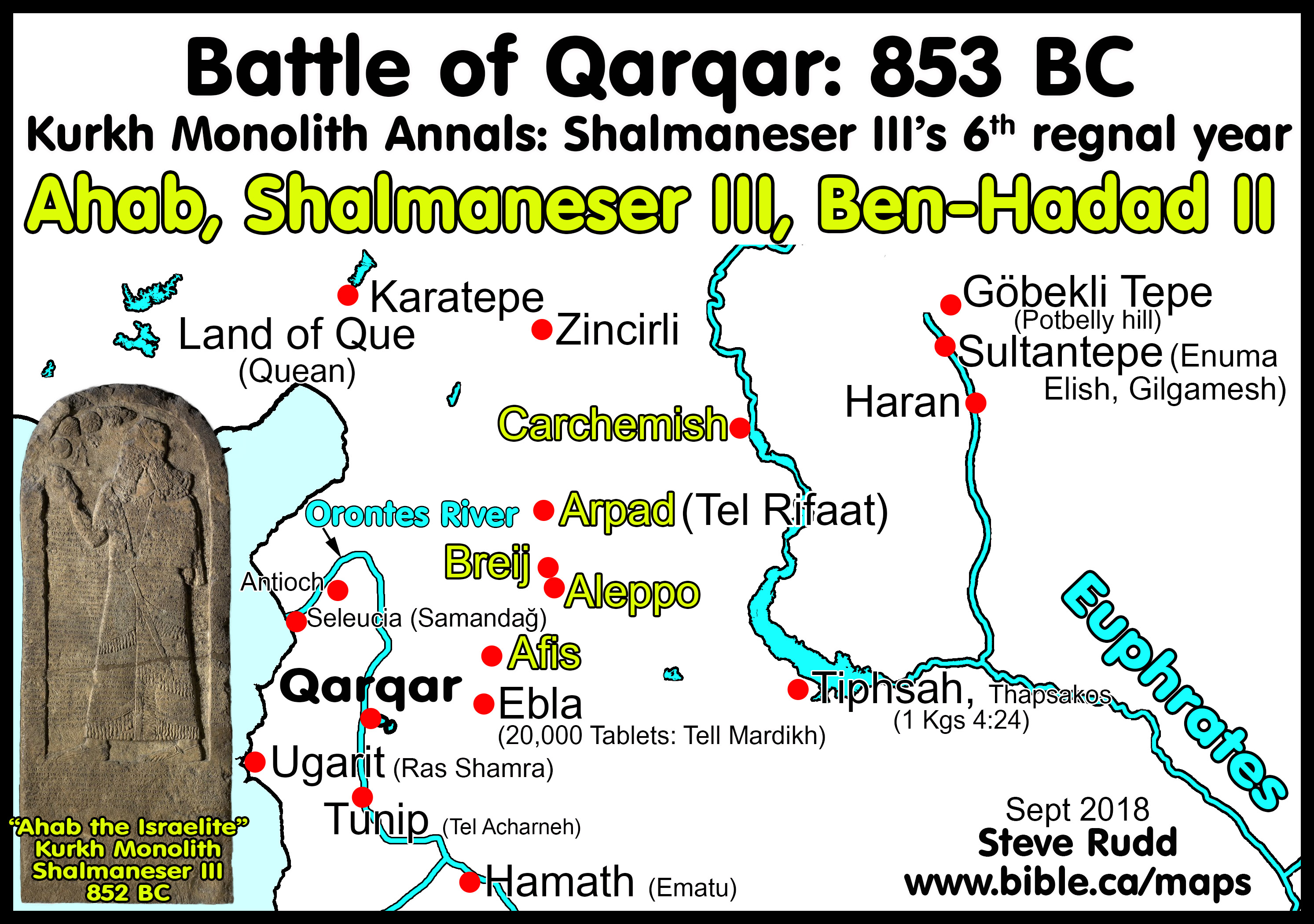
b. 849 BC, Year 10: Battle of Carchemish with Ben-Hadad II and 12 kings, one of whom was Jehoram, king of Israel: [Note: Battle at Carchemish, then War with 12 kings Aram, Samaria] “At that time, Hadadezer (Adad-idri) [Ben-Hadad II], the Damascene, (and) Irhulenu, the Hamatite, together with twelve kings on the shore of the sea.” (Column II, line 62, Clay Tablet)
c. 848 BC, Year 11: Battle of Hamath: War with Ben-Hadad II and 12 kings, one of whom was Jehoram, king of Israel: “At that time Hadad-ezer (Adad-idri) [Ben-Hadad II], the Damascene, (and) Irhulënu, the Hamatite, together with twelve kings.” (Column III, line 1, Marble tablet)
d. 845 BC, Year 14: Battle of Hamath: War with Ben-Hadad II and 12 kings of Aram, Samaria, one of whom was Jehoram, king of Israel: “I crossed the Euphrates in flood with 120,000 of my troops. At that time Hadad-ezer (Adad-idri) [Ben-Hadad II], the Damascene, (and) Irhulënu, the Hamatite, together with twelve kings on the shore of the sea.” (Column III, line 20).
e. 845 BC, Year 14: The Melqart Stele was erected by Ben-Hadad II in preparation for this battle.
i. The stele was erected as a kind of “rabBit’s foot” lucky charm to invoke the assistance of the pagan god named “Melqart”.
ii. Of course, Shalmaneser was also invoking the assistance of his own pagan god’s names “Assur”.
iii. See also full outline on Melqart
Stele
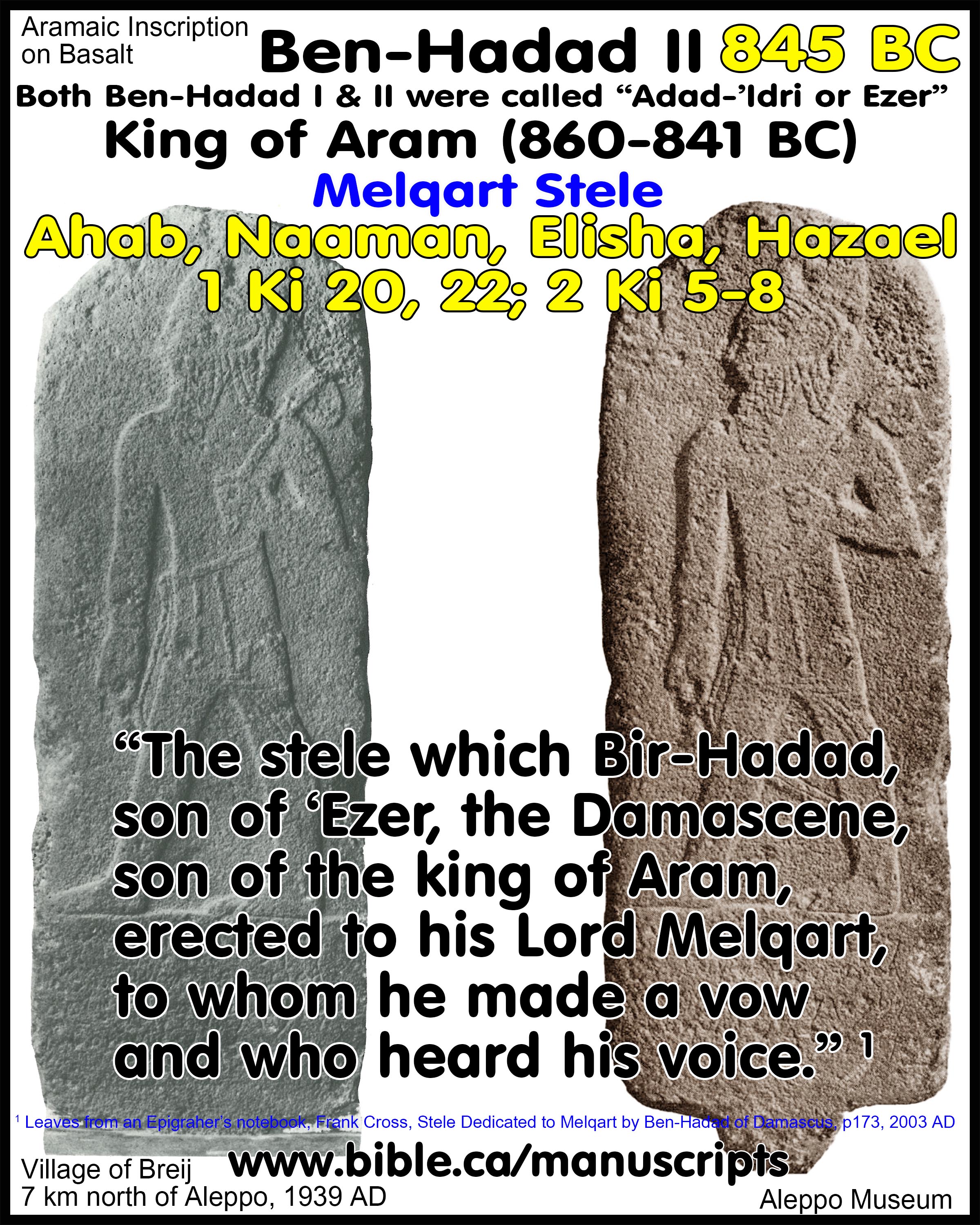
f. 841 BC, Year 18: Siege of Damascus: against Hazael: “Hazael of Damascus, trusting in the might of his soldiers, carried out an extensive muster of his troops, (Column III, line 50) He fortified Mount Saniru, the mountain peak, which is before Mount Lebanon. I put to the sword 16,020 of his fighting men (and) took away from him 1,121 of his chariots (and) 470 of his cavalry with his military camp, (Column IV, line 1) To save his life he ran away (but) I pursued him. I imprisoned him in Damascus, his royal city, cut down his gardens, (and) burned his shocks, (Column IV, line 5) I marched to Mount Haurānu (and) razed, destroyed, burned, (and) plundered cities without number. I marched to Mount Ba’lira’asi, which is a cape (jutting out into) the sea before the land of Tyre, (and) (Column IV, line 10) erected my royal statue there. I received tribute from Ba’ali-manzeri of Tyre (and) from Jehu (Iāu) of the house of Omri (Humri).” (Column III, line 50 - Column IV, line 10)
5. Note: The text of the twin monumental bulls (Twin Bulls) and clay tablet #54669 (see Marble and clay Tablets) are almost identical.
6. Sources:
a. The Royal inscriptions of Mesopotamia. Assyrian periods Vol. 3, A. Kirk Grayson, p50, 1996 AD
7. See Detailed outline on Shalmaneser III
I. About the Marble Annal Tablet: IM #55644 (Photo above)
1. Annals stone tablet Iraq Museum, #55644
2. Annal Years 0-20
3. In 1903 AD, both the marble (IM # 55644) and clay (IM # 54669) annals tablets were found in Outer wall of Assur (Kalat Sherkat), 1903 AD
4. “This lengthy version of the annals is engraved on a large stone tablet found in the wall of Aššur (with ex. 1 of A.0.102.6 = IM #54669, see below). It begins (i 1-9) with a brief invocation of the gods followed by the royal name and a few epithets (i 10- 18). The text then goes on to narrate the campaigns of the first twenty years (i 19 - iv 33), the narrative being more detailed for the later campaigns. The military section concludes with a summary of the booty won (iv 34-39). Then the text describes work on the wall of the quarter called New City at Aššur and we are told that previous kings who worked on this fortification were Puzur-Assur III, Adad-nārāri I, Tukultď-Ninurta I, and Tiglath-pileser I. No texts of Puzur-Aššur III regarding such work have been recovered but Adad-nārārī I, in recording his own work on New City's wall (RIMA 1 pp. 143-44 and 147-48), also mentions Puzur-Assur (III) as a previous builder. Contemporary records of such construction have been preserved for Tukultď- Ninurta I (RIMA I pp. 266-67) and Tiglath-pileser I (RIMA 2 pp. 35-38). The text concludes with the date, twentieth regnal year (839 BC), and a statement regarding the number of chariots and cavalry in Shalmaneser's army. (The Royal inscriptions of Mesopotamia. Assyrian periods Vol. 3, A. Kirk Grayson, p50, 1996 AD)
5. COMMENTARY The stone tablet (IM 55644) was found together with the clay tablet edited as A.0.102.6 in the outer wall of Aššur. It measures 80x60 cm and the inscription has been collated from the published photos. A piece of inscribed stone slab (Ass 862 + 873, Ass ph 559) duplicates portions of lines iii 20-36. While this may be the remains of a separate text, it has been included as "ex. 2" for convenience. There are no significant variants and only a little Bit of inscription is extant, so no scores have been given. The present location of the fragment is unknown. It has been collated from the excavation photo. The portions preserved are similar to those on the obverse of the fragment edited as A.0.102.13, but they cannot join. A copy of a fragmentary inscription in Istanbul (A 659, Ass 8558, Ass ph 1260 and 1362 — numbers uncertain) was found among the Hulin papers. It is a duplicate, with minor vars. (noted under "ex. 3"), of ii 29 - iii 10a.” (The Royal inscriptions of Mesopotamia. Assyrian periods Vol. 3, A. Kirk Grayson, p50, 1996 AD)
II. About the Clay Annal Tablet: IM #54669 (No photo)
1. Annals clay tablet Iraq Museum, #54669, size: 310 x 235 cm
2. Annal years 0-16
3. In 1903 AD, both the marble (IM # 55644) and clay (IM # 54669) annals tablets were found in Outer wall of Assur (Kalat Sherkat), 1903 AD
4. The text of the twin monumental bulls (Twin Bulls) and clay tablet #54669 (see Marble and clay Tablets) are almost identical.
5. “This edition of the annals, on clay tablets from Assur, is dated 842 BC and has a description of the military campaigns down to 843 BC. It begins (i 1— 27) with an invocation of gods, a passage which is a virtual duplicate of the introduction to A.0.102.2 (i 1-11). Then it has a narration (i 28 - iv 25) of military campaigns in chronological order for the accession year and first sixteen regnal years of Shalmaneser IIFs reign. The text concludes with a series of short paragraphs describing, in order, the conquests geographically (iv 26-36), the appointment of governors and regulation of tribute (iv 37- 39), hunting (iv 40-44), the increase of agricultural production (iv 45-46), and the tremendous growth in the size of the Assyrian army (iv 47^48). These latter themes were introduced to Assyrian annals in the time of Tiglath-pileser I (see RIMA 2 pp. 7-8). The text ends abruptly with the date, there being no building description or blessings and curses.” (The Royal inscriptions of Mesopotamia. Assyrian periods Vol. 3, A. Kirk Grayson, p32, 1996 AD)
6. “COMMENTARY Only ex. 1 [IM 54669], which is the master text, is complete. All the other exs. are mere fragments and the identification of these miscellaneous Bits as exs. of one text is mainly to the credit of Schramm. Ex. 1 is inscribed on a large clay tablet which was found, together with the stone tablet included as A.0.102.10, in the outer wall of Aššur. Most of the other exs. also came from Ašsur and it seems reasonable to assume that the few for which no provenance is known came from that site (except ex. 11 — see below). All exs. are on clay tablets, or fragments thereof, and inscribed either in two columns per side (exs. 1, 3-6, and 8), or one column per side (exs. 2, 7, 9, 10, and 12). This distinction was pointed out by Schramm, who observed that exs. 2, 7, 9, and 10 (also 12), although very fragmentary, have in general one line for every two in ex. 1, and therefore their lines must have stretched right across the tablet. The other exs. (3-6 and 8) have more or less the same line length as ex. 1, and therefore must have had two columns per side. Indeed, traces of two columns on each side are preserved on exs. 4 and 5. None of the fragments seems to join physically. Nevertheless, some probably belong to the same tablet and Schramm has theorized that they may come from as few as three four-column tablets and two two-column tablets; but I suspect there were more. A few exs. need special comment. On ex. 4 there are scant, illegible traces at scattered points between i 58 and iii 52. There are some illegible traces on the reverse of ex. 8. The fragment catalogued as "ex. 11" is, in fact, a separate text, A.0.102.7. It has been edited here because all that remains duplicates a few lines in A.0.102.6. But it comes from Calah, not Aššur, and clearly was not as lengthy a text as A.0.102.6 (the rev. of ex. 11 only reaches as far as i 49 before it breaks off). The fragment has not been located or collated. I am grateful to Deller for bringing to my attention ex. 12.” (The Royal inscriptions of Mesopotamia. Assyrian periods Vol. 3, A. Kirk Grayson, p50, 1996 AD)
III. Translation of the two marble and clay annals tablets:
Note: The text of the twin monumental bulls (Twin Bulls) and clay tablet #54669 are almost identical
|
Date Regnal Year Nisan |
Marble Annals Tablet: See photo above Iraq Museum #55644 Years 0-20 |
Clay Annals Tablet: No Photo Iraq Museum #54669, Size: 310 x 235 cm Years 0-16 |
|
Jan 858 BC Year 0 intro |
Aššur, great lord; Anu, exalted god; god Enlil, perfectly magnificent; god Adad. canal-inspector of heaven and underworld; god Ninurta, foremost among the gods, lord of battle and strife; (Column I, Line 5) goddess Istar, foremost in heaven and underworld; god Ea, king of the apsű, lord of wisdom (and) understanding; god Sîn, king of the lunar disk, lord of brilliance; god Marduk, sage of the gods (and) lord of omens; great gods who decree destinies: (Column I, lines 1-9)
Shalmaneser, king of all people, prince, vice-regent of Aššur, strong king, king of all the four quarters, sun(god) of all people, ruler of all lands; son of Ashurnasirpal (II), exalted priest whose priesthood was pleasing to the gods and (who) subdued (Column I, line 15) all lands at his feet, pure offspring of Tukultď-Ninurta (II), who slew all his enemies and annihilated (them) like a flood: (Column I, lines 10-18) |
God Aššur, great lord, king of all the great gods; god Anu, king of the Igigu and Anunnaku gods, lord of the lands; god Enlil, exalted one, father of the gods, creator of all; god Ea, king of the apsu, lord of wisdom and understanding; god Sîn, king of the lunar disk, lofty luminary; (Column 1, line 5) god Šamaš, lofty judge of heaven (and) underworld, lord of all; god Ninurta, strong and mighty one, splendidly preeminent of the gods; goddess Ištar, mistress of war and battle, whose game is fighting; great gods, who decree destinies, who aggrandize my sovereignty, who have made great my dominion, power, and leadership, (who) have richly established for me my honourable name (and) my lofty command over (all) lords; (Column 1, lines 1-10)
Shalmaneser, king of all people, prince, vice-regent of Aššur, strong king, king of all the four quarters, sun(god) of all people, ruler of all lands, king, desired object of the gods, chosen of the god Enlil, trustworthy appointee of Aššur, attentive prince, (Column 1, line 15) who has seen remote and rugged regions, who has trodden upon the mountain peaks in all the highlands, receiver of booty and tax from all the (four) quarters, who opens paths above and below, at whose strong attack for combat the (four) quarters are distressed (and) (Column 1, line 20) cities convulsed, strong male who acts with the support of Aššur (and) the god Šamaš, the gods his allies, and has no rival among the princes of the four quarters, magnificent king of lands, who has kept progressing by difficult ways through mountains and seas; (Column 1, lines 11-23)
son of Ashurnasirpal (II), exalted prince, whose priesthood was pleasing to the gods and (who) subdued all lands at his feet, pure offspring of TukultT-Ninurta (II), who slew all his enemies and annihilated (them) like a flood: (Column 1, line 24-27) |
|
858 BC, Year 0 pre-Nisan |
At the beginning of my reign, after I ascended the royal throne, I mustered my chariots (and) troops. I entered the pass of the land Simesi (and) captured the city Aridu, the fortified city of Ninnu. (Column I, lines 19-23a) |
At that time, in my accession year, after I nobly ascended the royal throne, I mustered my chariots and troops. I entered the pass of the land Simesi (and) (Column 1, line 30) approached the city Aridu, the fortified city of Ninnu. I besieged the city, captured (it), massacred many of their (people), (and) carried off booty from them. Moving on from the city Aridu, I approached the city yubuškia. I burned the city Hubuskia together with 100 cities in its environs. Kāki, king of the city Hubuskia (Column 1, line 35), became frightened in the face of the flash of my mighty weapons and fortified himself on a mountain. I climbed up the mountain after him. I waged mighty war on the mountain (and) brought down from the mountain the remains of his property. Moving on from the city Hubuškia I marched to the sea of the land Nairi. I washed my weapons in the sea (and) made sacrifices to my gods. On my return from the sea I received tribute from Asű the Gilzanean (and) brought (it) to my city Aššur. (Column 1, lines 28-41) |
|
858 BC Year 1 Nisan |
In my first regnal year I crossed the Euphrates (and) marched to the western sea. I washed my weapons in the sea (and) made sacrifices to my gods. I climbed up the Amanus range (and) cut beams of cedar (and) juniper. I climbed up Mount Lallar (and) erected therein my royal statue. (Column I, lines 23b-30a) |
In my first regnal year I crossed the Euphrates in flood (and) marched to the western sea. I washed my weapons in the sea (and) made sacrifices to my gods. I climbed up the Amanus range (and) cut beams of cedar (and) juniper, (Column 1, line 45) I climbed up Mount Lallar (and) erected therein my royal statue. I razed, destroyed, (and) burned the cities of the Patineans, of Afcunu, the man of Bit- Adini, of the Carchemishites, (and) of the Bit- (A)gūsi, which are on the other side of the Euphrates. (Column 1, lines 42-48) |
|
857 BC Year 2 |
In my second regnal year I approached the city Til-Barsip (Barsaip), captured the cities of Ahunu, the man of Bit-Adini, (and) confined him to his city. I crossed the Euphrates in flood (and) captured the city Dabigu, fortress of the land Hatti, together with cities in its environs, (Column I, lines 30b-36a) |
In my second regnal year I moved out from Nineveh (and) approached the city Til-Barsip (Barsaip). I razed, destroyed, (and) burned the cities of Ahunu, the man of Bīt-Adini, (and) confined him to his city. I crossed the Euphrates in flood. On (this) my second campaign I captured, razed, destroyed, (and) burned the city Dabigu, fortress of the land Hatti, together with cities in its environs and the remaining cities of all their lands. I received (Column 1, line 55) tribute from all the kings on the other side of the Euphrates (and) accomplished everywhere my mighty victories over all the lands. (Column 1, lines 49-56) |
|
856 BC Year 3 |
In my third regnal year Ahunu, the man of Bit-Adini, became frightened in the face of my mighty weapons and abandoned the city Til-Barsip (Barsaip), his royal city. He crossed the Euphrates. I took as my own (Column I, line 40) the city Ana-Aššur-utēr-asbat, which is on the other side of the Euphrates by the River Sagura, which the people of Hatti call the city Pitru. On my return (Column I, line 45) I entered the pass of Alzu (and) captured Alzu, the lands Suhme, Daiēnu, Turnrnu, the city Arsaskun, the land Gilzānu, (and) the city yubuškia. (Column I, lines 36b-48a) |
In my third regnal year Ahunu, the man of Bit-Adini, became frightened in the face of my mighty weapons, abandoned the city Til-Barsip (Bursaip), his royal city, (and) crossed the Euphrates. Moving out from Nineveh I took as my own the cities Til-Barsip (Bursaip) (and) Pitiru (Column 1, line 60), (cities) which are on the other side of the Euphrates (and) which Tiglath-pileser (I), my ancestor, had established. On my return I entered the pass of Alzu. (I marched) from Alzu to the land Suhme, from the land Suhme to the land Daiēnu, from the land Daiēnu to the city Arsaskun, the royal city (Column 1, line 65) of Aramu the Urartian. Aramu trusted in the strength of his army and mustered his numerous cavalry to wage war and battle against me. I defeated him (and) deprived him of his cavalry (and) military equipment. To save his life he climbed up a rugged mountain (Column 1, line 70). They (his people) became frightened in the face of my mighty weapons, abandoned their cities, and took to a rugged mountain. I captured the city Arsaskun, his royal city, together with cities in its environs. I brought out his incalculable possessions and property (and) razed, destroyed, (and) burned the(se) cities, (Column II, line 1 ) I annihilated like a flood from the land Gilzānu to the city Hubuškia. From the pass of Mount Kirruru I emerged before the city Arbail. (Column 1, line 57 – Column II, line 2) |
|
855 BC Year 4 |
In my fourth regnal year I crossed the Euphrates in flood in pursuit of Ahunu, the man of Bīt-Adini. (ii 1) He had made as his stronghold Mount Sitamrat, a mountain peak on the bank of the Euphrates. I besieged (and) captured the mountain peak. Ahunu, together with his gods, his chariots, his horses, (and) 22,000 of his troops I uprooted (and) brought to my city, Aššur. (Column I, line 48b – Column II, line 6a)
In this same year I crossed Mount Kullar, went down to the interior of the land Zamua, (and) captured the cities of Nikdęra and Nikdeme. (Column II, lines 6b-9a) |
In my fourth regnal year, on the thirteenth day of the month Iyyar, I moved out from Nineveh (and) crossed the Euphrates in flood in pursuit of Ahunu, the man of Bīt-Adini. He had made as his stronghold (Column II, line 5) Mount Šītamrat, a mountain peak on the bank of the Euphrates which is suspended from heaven like a cloud. I besieged (and) captured the mountain peak. Ahunu, together with his gods, his chariots, his horses, (and) 22,000 of his troops I uprooted (and) brought to my city, Assur. (Column II, lines 10-15) In this same year I moved out from Inner City (Assur), crossed Mount Kullar, went down to the interior of the land Zamua, (and) captured the cities of Nikdęra, the Idean. The remnant of their army boarded boats of papyrus and escaped by sea. I boarded boats of inflated skins (and) pursued them. I defeated them in the midst of the sea (and) plundered them. (Column II, lines 3-9) |
|
854 BC Year 5 |
In my fifth regnal year I ascended Mount Kasiiari (and) captured eleven fortified cities. I confined Anhitti, the Subraean, to his city (and) received his tribute. (Column II, lines 9b-12) |
In my fifth regnal year I moved out from Nineveh and ascended Mount Kašiiari. I captured eleven fortified cities (and) confined Anhitti the Šubraean to his city (and) received his tribute. Column II, lines 16-18) |
|
853 BC Year 6 Battle of Qarqar with Ben-Hadad II and 12 kings. Eponymy of Daiiān-Aššur
|
In my sixth regnal year I approached the cities on the banks of the River Balih. They killed Giammu, their city ruler. I entered the city Til-turahi. I crossed the Euphrates in flood (and) received tribute from the kings of the land Hatti. Hadad-ezer (Adad-idri) [Ben-Hadad II], the Damascene, Irhulënu, the Hamatite, together with twelve kings on the shore of the sea, (Column II, line 20) trusting in their united forces, attacked me to wage war and battle. I fought with them (and) defeated them. I captured from them their chariotry, cavalry, (and) military equipment (and) put to the sword 25,000 of their fighting men. (Column II, lines 13-25) |
In my sixth regnal year I moved out from Nineveh and approached the cities on the banks of the River Balih (Palih). They became frightened in the face of my mighty weapons and killed Giammu, their city ruler. I entered the city Til-turahi (and) claimed the city as my own. Moving on from the banks of the River Balih (Palih) I crossed the Euphrates in flood. I received tribute from the kings of the land Hatti. (Column II, line 25) Moving on from the land Hatti I approached the city Aleppo (Halman) (and) made sacrifices before the god Adad of Aleppo. Moving on from Aleppo (Halman) I approached the city Qarqar. Hadad-ezer (Adad-idri) [Ben-Hadad II], the Damascene, (and) Irhulënu, the Hamatite, together with twelve kings on the shore of the sea, trusting in their united forces, (Column II, line 30) attacked me to wage war and battle. I fought with them. I put to the sword 25,000 of their fighting men (and) captured from them their chariotry, cavalry, (and) military equipment. To save their lives they ran away. I boarded boats (and) went out upon the sea. (Column II, lines 19-33) |
|
852 BC Year 7 |
In my seventh regnal year I marched to the cities of gabinu, the Til-abnīan. I captured Til-abni, his fortified city, together with the cities in its environs. I marched to the source of the Tigris, the place where the water comes out. (Column II, lines 26-30) |
In my seventh regnal year I marched to the cities of Habinu, the Til-abnlan. I captured (and) burned Til-abni, his fortified city, together with the cities in its environs. Moving on from Til-abni I marched to the source of the Tigris, the place where the water comes out, (and) made sacrifices. I put to the sword (the inhabitants of) cities insubmissive to Aššur (and) received tribute from the land Nairi. (Column II, lines 34-40) |
|
851 BC Year 8 |
In my eighth regnal year (at the time of) Marduk-zäkir-sumi (I), king of Kardunias, Marduk-bel-usŕte, his brother, rebelled against him. I marched out for vengeance (and) captured the cities Mę-turnat (and) Lahiru. (Column II, lines 31-34) |
In my eighth regnal year, at the time of Marduk-zākir-šumi (I), king of Kardunias, Marduk-bel-usāte, his brother, rebelled against him. I marched out for vengeance (and) captured the cities Me-turnat and Lahiru. (Column II, lines 41-44) |
|
850 BC Year 9 |
In my ninth regnal year, in my second campaign (to Babylonia), I captured the city Gannanāte. To save his life Marduk-bël-usâte ascended a mountain. I pursued him (and) (Column II, line 40) put to the sword Marduk-bël-usâte, together with the treacherous soldiers who were with him. I made sacrifices in Babylon, Borsippa, (and) Cuthah. I went down to Chaldaea (and) captured their cities. I received tribute from the kings of Chaldaea in Babylon. (Column II, lines 35-44 ) |
In my ninth regnal year, in my second campaign (to Babylonia), I captured the city Gannanäte. To save his life Marduk-bel-usāte went up to the city Halman. I pursued him (and) put to the sword Marduk-bel-usāte together with the treacherous soldiers who were with him. (Then) I marched to Babylon (and) (Column II, line 50) made sacrifices in Babylon, Borsippa, (and) Cuthah. I went down to Chaldaea (and) captured their cities. I marched to the sea called the Marratu ("Bitter") River (and) received tribute in Babylon from Adinu, the man of Bīt-Dakkuri, (and) from Musallim-Marduk, the man of Bīt-Amukkāni (Ukānu): silver, gold, ebony, (and) elephant ivory. (Column II, lines 45-54) |
|
849 BC Year 10 Battle of Carchemish with Ben-Hadad II and 12 kings |
In my tenth regnal year I crossed the Euphrates for the eighth time. <I captured> the cities of Sangara, the Carchemishite. Moving on from the cities of the Carchemishite I approached the cities of Aramu (and) captured Arnę, his royal city, together with one hundred cities in its environs. (Column II, lines 45-50) |
In my tenth regnal year I crossed the Euphrates for the eighth time. I razed, destroyed, (and) burned the cities of Sangara, the Carchemishite. Moving on from the cities of the Carchemishite I approached the cities of Aramu (and) captured the city Arnę, his royal city. I razed, destroyed, (and) burned (it) together with one hundred cities in its environs, (Column II, line 60) I massacred them (and) plundered them. At that time, Hadadezer (Adad-idri) [Ben-Hadad II], the Damascene, (and) Irhulenu, the Hamatite, together with twelve kings on the shore of the sea, trusting in their united forces, attacked me to wage war and battle. I fought with them (and) (Column II, line 65) defeated them, I took from them their chariotry, cavalry, and military equipment. To save their lives they ran away. (Column II, lines 55-67) |
|
848 BC Year 11 War with Ben-Hadad II and 12 kings |
In my eleventh regnal year I crossed the Euphrates for the ninth time. I captured ninety-seven cities of Sangara (and) one hundred cities of Aramu. I took to the slopes of the Amanus range, (Column II, line 55) crossed Mount Iaraqu, (and) descended to the cities of the people of Hamath. I captured the city Abšimaku (Aštammaku?), together with eighty-nine cities. At that time (Column III, line 1) Hadad-ezer (Adad-idri) [Ben-Hadad II], the Damascene, (and) Irhulënu, the Hamatite, together with twelve kings on the shore of the sea, trusting in their united forces, (attacked me) and I fought with them (and) defeated them. I put to the sword [10] ,000 of their fighting men. (Column II, line 51 – column III, line 5) |
In my eleventh regnal year I moved out from Nineveh (and) crossed the Euphrates in flood for the ninth time. I captured ninety-seven cities of Sangara. (Column II, line 70) I captured, razed, destroyed, (and) burned one hundred cities of Aramu. I took to the slopes of the Amanus range, crossed Mount laraqu, (and) (Column III, line 1) descended to the cities of the people of hamath. I captured the city Astammaku, together with eighty-nine (other) cities. I massacred their (inhaBitants) (and) plundered them. At that time Hadad-ezer (Adad-idri) [Ben-Hadad II], the Damascene, (and) Irhulënu, the Hamatite, together with twelve kings (Column III, line 5) on the shore of the sea, trusting in their united forces, attacked me to wage war and battle. I fought with them (and) defeated them. I put to the sword 10,000 of their fighting men. (Column III, line 10) I took from them their chariotry, cavalry, and military equipment. On my return I captured Aparāzu, the fortified city of Aramu. At that time I received tribute from Qalparunda: silver, gold, tin, horses, donkeys, oxen, sheep, blue-dyed wool, (and) linen garments. I went (back) up the Amanus range (and) cut beams of cedar. (Column II, line 68 – Column III, line 15) |
|
847 BC Year 12 |
In my twelfth regnal year I crossed the Euphrates for the tenth time (and) marched to the city Paqarahubunu. The people took to a rugged mountain. I massacred them (and) brought plunder (and) possessions of theirs down from the mountain, (Column III, lines 6-10a) |
In my twelfth regnal year I moved out from Nineveh (and) crossed the Euphrates for the tenth time. I marched to the land Paqarahubunu, (where) the people became frightened (and) took to a rugged mountain. I besieged (and) captured the mountain peak. I massacred them (and) (Column III, line 20) brought plunder and possessions of theirs down from the mountain. (Column III, lines 16-20) |
|
846 BC Year 13
|
In my thirteenth regnal year I entered the Pass of the Goddesses, marched to Matiātu, captured all of Matiātu, (and) plundered it. (Column III, lines 10b-13). |
In my thirteenth regnal year I entered the Pass of the Goddesses, marched to Matiātu, (and) captured all of Matiātu. I slaughtered their (inhabitants) (and) took countless plunder from them. (Column III, lines 21-23) |
|
845 BC Year 14 Melqart Stele. War with Ben-Hadad II and 12 kings Aram, Samaria |
In my fourteenth regnal year I mustered (the troops of my) extensive land in countless numbers (and) crossed the Euphrates in flood with 120,000 of my troops. At that time Hadad-ezer (Adad-idri) [Ben-Hadad II], the Damascene, (and) Irhulënu, the Hamatite, together with twelve kings on the shore of the sea, (Column III, line 20) above and below, mustered their troops, which were too numerous to be counted. They attacked me, I fought with them, (and) defeated them. I took away their chariotry, cavalry, (and) military equipment. To save their lives they ran away. (Column III, lines 14-25) |
In my fourteenth regnal year I mustered (the troops of my) extensive land in countless numbers (and) crossed the Euphrates in flood with 120,000 troops. At that time Hadad-ezer (Adad-idri) [Ben-Hadad II], the Damascene, (and) Irhulēnu, the Hamatite, together with twelve kings on the shore of the sea, above and below (Column III, line 30), mustered their troops, which were too numerous to be counted. They attacked me, I fought with them, (and) defeated them. I destroyed their chariotry (and) cavalry (and) took away their military equipment. To save their lives they ran away. (Column III, lines 24-33) |
|
844 BC Year 15 |
In my fifteenth regnal year I marched to the land Nairi. I erected my royal statue at the source of the Tigris on a mountain cliff, (Column III, line 30) I entered the pass of Mount Tubunu (and) captured the cities of Aramu, the Urartian, as far as the source of the Tigris (and) as far as the source of the Euphrates. (Column III, lines 26-33a) |
In my fifteenth regnal year I marched to the land Nairi. I created at the source of the Tigris, on a mountain cliff where its water comes out, my royal statue. I wrote thereon praises of my power (and) my heroic deeds. (Then) I entered the pass of Mount Tunibunu (and) (Column III, line 40) razed, destroyed, (and) burned the cities of Aramu, the Urartian, as far as the source of the Euphrates. (Thus) I marched to the source of the Euphrates, made sacrifices to my gods, (and) washed the weapons of Aššur therein. Asia, king of the land Daiēnu, submitted to me (and) I received from him tax and tribute of horses. I fashioned my royal statue (and) erected (it) inside his city. (Column III, lines 34-45)
On my return from the source of the Euphrates I marched to the land Suhni I captured five fortified cities together with the cities in their environs, massacred their (inhabitants) (and) plundered them, (Column III, line 50) Moving on from the land Suhni I approached the land Enzi. I captured two fortified cities together with the cities in their environs, massacred their (inhabitants), (and) plundered them. Moving on from the land Enzi (Column III, line 55) I approached the Euphrates before the land Melid. I received tribute from Lalla, the Melidite: silver, gold, tin, (and) bronze. I fashioned my royal statue (and) erected (it) by the Euphrates. Column III, lines 46-57) |
|
843 BC Year 16 eponymy of Taklāk-ana-šarri |
In my sixteenth regnal year I crossed Mount Kullar (and) conquered the lands Munna, Allabria, Parsua, Abdadānu, IJaban, Namri, (and) Tuglias. (Column III, lines 33b-37a) |
In my sixteenth regnal year I moved out from Arbail, crossed Mount Kullar, (and) (Column III, line 60) established a fortress in the interior of the land Zamua. I conquered from the interior of the land Zamua to the land Munna (and) from the land Munna to the land Allabria (and) the city Paddira, the fortified city of Ianziburias (Column IV, line 1), the Allabriaean. I took booty from him: a door of gold, his palace women, (and) the extensive property of his palace. I set ablaze (the regions stretching) from the city Allabria to the city Parsua, from the city Parsua to the city Abdadānu, (and) (Column IV, line 5) from the city Abdadānu to the city Haban, I overwhelmed them with my lordly brilliance. (Column III, line 58 – Column IV, line 6)
Marduk-mudammiq, king of the land Namri, trusting in the might of his troops, (Column IV, line 10) mustered his numerous cavalry to wage war and battle against me. He drew up a battle line opposite to me at the River Namritu. I defeated him and took from him his cavalry. Marduk-mudammiq, king of the land Namri, took fright in the face of my mighty weapons and abandoned the cities Šumurza, Bīt- Nergal, (and) (Column IV, line 15) Niqqu of the land Tuglias, his fortified cities (and) garrisons. To save his life he fled (and) I plundered his palaces. I took as plunder his gods, his possessions (and) property, his palace women, (and) (Column IV, line 20) his harness-trained horses without number. I received tribute from Barű, the Ellipean, in the pass of the land Tuglias. (Column IV, line 25) I overwhelmed the land Namri with awe of my weapons (and) my lordly brilliance. (Column IV, lines 7-25)
Conqueror from the upper and lower seas to the land Nairi and the great sea of the west as far as the Amanus range: I gained dominion over the entire land 0atti. (Column IV, line 30) I (lit. "he") conquered from the source of the Tigris to the source of the Euphrates. I annihilated like a flood from the land Enzi to the land Suhni (Su>unu), from the land Suhni to the land Melid, from the land Melid to the land Daiënu, from the land Daiēnu to the city Arsaskun, from the city Arsaskun (Column IV, line 35) to the land Gilzanu, (and) from the land Gilzānu to the city Hubuškia. (Column IV, lines 26-36)
In the lands and mountains over which I gained dominion I appointed governors everywhere and imposed upon them tax, tribute, (and) corvée. (Column IV, lines 37 - 39)
The gods Ninurta and Nergal, who love my priesthood, gave to me the wild beasts and commanded me to hunt. I killed from my ... chariot 373 wild bulls (and) 399 lions with my valorous assault. I drove twenty-nine elephants into ambush. (Column IV, lines 40-44)
I hitched up plows in the (various) districts of my land (and thereby) piled up more grain and straw than ever before. Column IV, lines 45-46)
I hitched up teams of horses to 2,002 chariots (and equipped) 5,542 cavalry for the forces of my land. (Column IV, lines 47-48)
The month Tashrit, the twenty-second day, eponymy of Taklāk-ana-šarri, governor of the city Nēmed-Ištar. Column IV, lines 49-51) |
|
842 BC Year 17 |
In my seventeenth regnal year I crossed the Euphrates (and) received tribute from the kings of the land Hatti. I ascended the Amanus range, (Column III, line 40) cut down cedar timbers, (and) brought (them) to my city, Aššur. On my return from the Amanus range I slew sixty-three perfect specimens of strong, horned, wild bulls by the city Zuqarru, on the opposite bank of the Euphrates, (and) captured four alive. (Column III, lines 37b-45a) |
|
|
841 BC Year 18 War with Hazael |
In my eighteenth regnal year I crossed the Euphrates for the sixteenth time. Hazael of Damascus, trusting in the might of his soldiers, carried out an extensive muster of his troops, (Column III, line 50) He fortified Mount Saniru, the mountain peak, which is before Mount Lebanon. I put to the sword 16,020 of his fighting men (and) took away from him 1,121 of his chariots (and) 470 of his cavalry with his military camp, (Column IV, line 1) To save his life he ran away (but) I pursued him. I imprisoned him in Damascus, his royal city, cut down his gardens, (and) burned his shocks, (Column IV, line 5) I marched to Mount Haurānu (and) razed, destroyed, burned, (and) plundered cities without number. I marched to Mount Ba’lira’asi, which is a cape (jutting out into) the sea before the land of Tyre, (and) (Column IV, line 10) erected my royal statue there. I received tribute from Ba’ali-manzeri of Tyre (and) from Jehu (Iāu) of the house of Omri (Humri). On my return I ascended Mount Lebanon (and) erected my royal statue with the statue of Tiglathpileser, a strong king who preceded me. (Column III, line 45b – Column IV, line 15a) |
|
|
840 BC Year 19 |
In my nineteenth regnal year I crossed the Euphrates for the seventeenth time (and) received tribute from the kings of the land Hatti. I ascended the Amanus range, cut down cedar and juniper timbers, (and) brought (them) to my city Aššur. On my return (Column IV, line 20) from the Amanus range I slew ten perfect specimens of strong, horned, wild bulls (and) two calves by the city Zuqarru, on the opposite bank of the Euphrates. (Column IV, lines 15b-22a) |
|
|
839 BC Year 20 |
In my twentieth regnal year I crossed the Euphrates for the twentieth time (and) mustered with my (forces) all the kings of the land Hatti. I crossed the Amanus range (and) went down (Column IV, line 25) to the cities of Katę, the Quean (Qau). I captured the cities Lusanda, Abarnānu, Kisuatnu, fortified cities together with innumerable cities from the nearest of his cities to the farthest of his cities, (Column IV, line 30) I massacred (and) plundered them. I fashioned two royal statues of myself, inscribed thereon my mighty praises (and) erected one in the nearest of his cities (and) the second in the farthest of his cities on a cape (jutting) into the sea. (Thus) I prevailed over the land (lit. "city") Que (Qau) with might and main. Column IV, lines 22b-34a)
The booty from the beginning of my sovereignty to my twentieth regnal year: 110,610 prisoners, 82,600 killed, 9,920 horses (and) mules, 35,565 oxen, 19,690 donkeys, (and) 184,755 sheep. (Column IV, lines 34b-40a)
At that time the ancient wall of my city, Aššur, of New City, which had been built previously by Puzur-Aššur (III), son of Aššur-nārāri (I), Adad-nārārī (I), son of Arik-dīn-ili, Tukulti-Ninurta (I), son of Shalmaneser (I), (and) Tiglath-pileser (I), (Column IV, line 45) son of Aššur-rēša-iši (I), kings who preceded me: this wall had become dilapidated and I removed its damaged (portions), digging down to its foundation in bedrock. I completely rebuilt it from top to bottom (and) (Column IV, line 50) decorated (it) more splendidly than before. I made it <N> layers of brick high and thirteen bricks wide, using the large brick mould (as standard). I mixed its clay with honey, fine oil, cedar resin, beer, (and) wine. I made its bricks with trowels (and) moulds of cedar. I deposited in its foundation silver, gold, (Column IV, line 40b - Lower edge, line 3a) lapis lazuli, pappardilű-stone, carnelian, shells, aromatics, all kinds of things. I used baked bricks of ... on its towers. I deposited my monumental and clay inscriptions therein. (Lower edge 1) May a later prince restore its weakened portions (and) return my inscriptions together with the inscriptions of the kings my fathers (Lower edge 3b -Left edge 1a) to their places. (Then) Assur, the god Adad, (and) the great gods will listen to his prayers. (Left edge 1) (Assyrian) month Ša-kīnāte, (Babylonian) month Tishri, first day, eponymy of my twentieth regnal year. (Left edge lb-2a) I recruited for the armed forces of my land 2,001 chariots (and) 5,242 cavalry. (Left edge 2b) |
|
Conclusion:
1. The marble and clay tablets (two different annals tablets) of Shalmaneser III is a stunning confirmation of the historical accuracy of the Bible:
a. It names Jehu, Omri, Ben-Hadad II and Hazael
b. It names the city of Tyre.
2. The ending of the Marble tablet names a series of Assyrian kings:
a. Tukulti-Urta II (Assyria)
b. Assur-nâsir-pal II (Assyria)
c. Puzur-Aššur (III) son of Aššur-nārāri (I)
d. Adad-nārārī (I) son of Arik-dīn-ili
e. Tukulti-Ninurta (I) son of Shalmaneser (I)
f. Tiglath-pileser (I) son of Aššur-rēša-iši (I)
3. We learn new information that happened in 841 BC:
a. After meeting with Elisha in 2 kings 8 and being told he will be the new king who will defeat Israel, Hazael decides to attack Syria!
b. The Bible tells us that Hazael killed King Ben-Hadad II.
c. We learn that Hazael took offensive military maneuvers against Assyria and Shalmaneser III counter-attacked Hazael and penned him up inside Damascus in a siege. “I imprisoned him in Damascus, his royal city, cut down his gardens, (and) burned his shocks, (Column IV, line 4)
d. The arrogant confidence of Hazael after meeting Elisha was misplaced.
4. Five of six battles between Israel and Assyria: It highlights the ongoing battles between Shalmaneser III of Assyria and the coalition of 12 kings under the command of Ben-Hadad II of Aram (Damascus) which included three Israeli kings: Ahab, Jehoram and Jehu.
a. 853 BC, year 6. The battle of Qarqar
b. 849 BC, Year 10: Battle of Carchemish
c. 848 BC, Year 11: Battle of Hamath
d. 845 BC, Year 14: Battle of Hamath
e. 841 BC, Year 18: Siege of Damascus
5. 845 BC, Year 14: The Melqart Stele was erected by Ben-Hadad II in preparation for this battle.
6. What you read in the book, you find in the ground! Find me a church to attend in my home town this Sunday!
|
9 Inscriptions of Shalmaneser III |
||
|
|
|
|
|
|
|
|
By Steve Rudd: Contact the author for comments, input or corrections.
